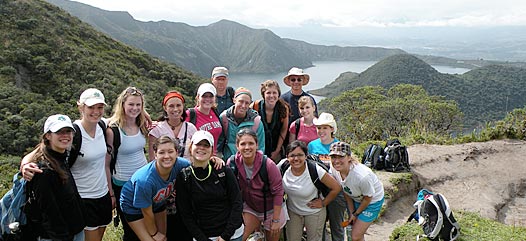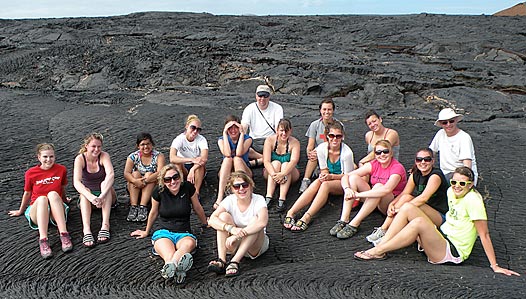In Darwin’s Footsteps
by Ann Jacobson

Reading about Charles Darwin’s exciting discoveries about the unique fauna, floral, and animal species in the Galapagos Islands in black ink doesn’t even compare to actually walking in his footsteps there, say two Saint Mary’s students who have done just that. That comes as no surprise to biology Professor Thomas Fogle, Ph.D. “International learning is like a gigantic 3-D classroom where you are surrounded by opportunities to grow and become more aware and enlightened,” he says. His “Special Topics in Biology (490): Environments of Ecuador,” class travels biennially for a few weeks to Ecuador, one of the most environmentally diverse countries in the world. There, his students delve into population dynamics, interactions among organisms, the impact and consequence of human presence, and local efforts at conservation. The setting for this undertaking involves four distinct environments in Ecuador: a cloud forest, the barren Andes highlands, the Amazon rainforest, and the Galapagos volcanic archipelago of islands owned by Ecuador, where an amazed Darwin first recorded his findings in 1885.
Chemistry Major Amelia McGannon ’11 of Kansas City, Missouri, was among 14 students who ventured on this biological journey to Ecuador with Fogle last summer (2010). Before that, her vision of Ecuador’s Amazon Rainforest had been gleaned from only movies such as Jungle Book and Tarzan. “To my surprise, the parts of the rainforest that we explored did not resemble this image at all,” she says. “What surprised me even more was how much more I enjoyed the rainforest because it was not the glamorized image I thought it would be. It was raw and untouched.” Her visit to the Amazon Basin helped her to more fully grasp concepts of chemical processes learned in campus classrooms, she says.

The trip is also designed as an intercultural learning experience, Fogle says. Such experiences include spending a day with the Quichua people in the rainforest, touring a part of Quito that was built by the Conquistadors 500 years ago, and dining on local delicacies, like native guinea pig. Mona Rodriguez ’12, a biology major from Madera, California, found daily life in the Galapagos Islands (which are only about three percent inhabited) as rich of an experience as seeing its biological wonders. “Coming from the States, this was a totally different environment for us. It was eye-opening to see and experience firsthand what local life is like for the small population of people who live on these islands, specifically for young kids going to school,” Rodriguez says. McGannon says that while applying what she learned in the classroom to actual environments was valuable, “the most monumental thing I learned had nothing to do with science. Interacting with the natives and experiencing their everyday life opened my eyes to how materialistic many of us are,” she says. “Many of the Ecuadorians that we came into contact with had very few tangible things, but were immensely happy and loving. This approach to life encouraged me to live more simply and take less for granted.”
Rodriguez’s post-graduate career goals include medical research in Oncology. “This trip opened my eyes to how a big portion of the world lives. I would like to go back someday and help in the small villages that often go unnoticed simply because they’re hidden in remote locations without modern technology for easy modes of communication,” she says. “I learned that 25 percent of Western pharmaceuticals are derived from rainforest ingredients, which is quite remarkable. I think there’s great potential for the rainforest in terms of research applications for modern medicines.” After graduation, McGannon plans on taking a year to work and gain more life experience prior to attending graduate school. “This trip to Ecuador opened my eyes to all of the possibilities that the field of science provides,” she says.
Both students agree that textbooks and classroom learning is greatly enriched when it extends to the real world, especially in new, faraway environments. “Now, I have a greater understanding of many different ecosystems from first-hand experience of living in these different environments and observing for myself in conjunction with a strong academic background from the material presented in class,” says Rodriguez. “It was like an episode of the discovery channel, but it was real and we were experiencing it for ourselves. Everything grows bigger in the Amazon…from trees to spiders! The entire program was an experience. We walked in Darwin’s footsteps and we traveled our own. Everyday brought textbooks and things we’ve learned to life.”
In the summer of 2012, another group of Biology Professor Thomas Fogle’s students is planning to venture to Ecuador to explore its four distinct ecosystems as part of his “Special Topics in Biology (490): Environments of Ecuador” class. Fogle came to teach at Saint Mary’s College in 1979 after finishing his graduate work at North Carolina State University. Other requirements of Course 490 include structured classroom learning, readings, and student projects sequential to the summer trip as well as students being charged with maintaining their own extensive journals, using Darwin writings as a model for their own, Fogle says. They are additionally required to write term papers on their travel experience upon their return to campus.
The itineraries for the trips to Ecuador have been slightly different, but with the same goals of studying Ecuador’s four distinct environments. Planned highlights of the class trip during the summer of 2012 include students:
- flying to Quito, Ecuador high in the Andes mountains and travel north near Otavalo, a dry and grassy area, for a day-long hike around a volcanic lake at 11,000 feet above sea level.
- traveling six hours to the Amazon basin, taking a hike along the way in a high-mountain rainforest (or cloud forest), home to more than a dozen of the 160 Ecuadorian hummingbird species. They’ll stay in an eco-friendly lodge in the rainforest and travel by motor canoe to various sites along the Napo River.
- visiting an animal rehabilitation center where animals are protected from hunting and the pet trade, both which flourish in the Amazon.
- returning to Quito to fly 600 miles west to the Galapagos, an archipelago of islands owned by Ecuador, where they will live on a boat for a week, traveling between islands learning about the plant and animal diversity there. They can also snorkel and swim, sometimes right off the boat.

